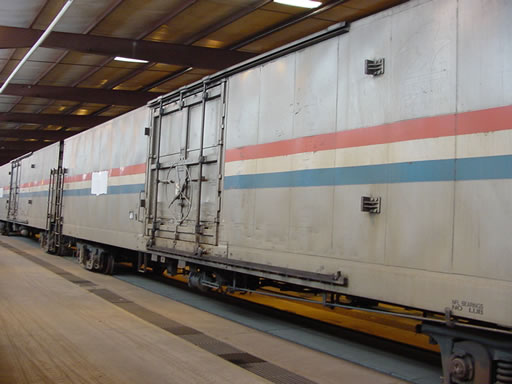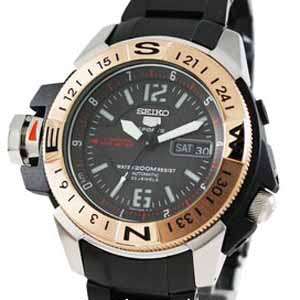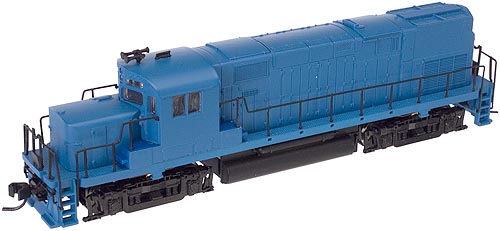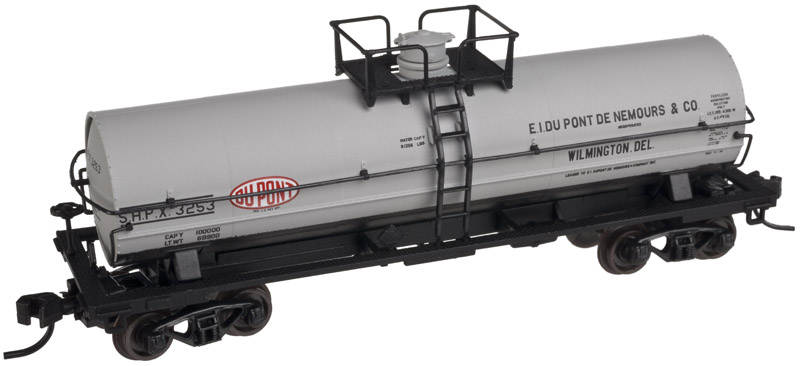Model Information: This model was introduced in 2016. It is part of Atlas' "Master" line of N Scale products. These Atlas N scale Plate B Boxcars feature early and late body styles with single sliding doors, body mounted couplers, and X-Panel roofs.
Prototype History: In the 1970's with the growth of the Per Diem business model, FMC produced a series of 50 foot box cars in different configurations. The single-sliding-door configuration is one of the best known and used widely by many different railroads. These cars were produced using the Gunderson metal works which FMC had acquired in 1965. In late 1975, FMC began producing a 5,077-cubic-foot Plate B box car for IPD and Railbox service. FMC's 5077s have seven panels to either side of the 10-foot door, an X-panel roof, and non-terminating ends that are slightly different from those used on FMC's earlier cars. Note how the sidesill is notched all the way back to the bolsters, a key feature of FMC's mature design.
The main difference between the 5077 cu. ft cars built by FMC vs the 5277-5347 cu. ft cars built by the same manufacturers is the overall height of the car, the smaller 5077 cars were Plate B while the larger 5277-5347 cars were Plate C. Over 4,300 cars were produced from 1975-1979 by FMC's Portland, Oregon plant. The cars were delivered in numerous colorful shortline paint schemes, as well as the nationwide car pool fleet of Railbox. Many secondhand cars were later seen in Class 1 railroads and large leasing company fleets under additional shortline reporting marks.
The main difference between the 5077 cu. ft cars built by FMC vs the 5277-5347 cu. ft cars built by the same manufacturers is the overall height of the car, the smaller 5077 cars were Plate B while the larger 5277-5347 cars were Plate C. Over 4,300 cars were produced from 1975-1979 by FMC's Portland, Oregon plant. The cars were delivered in numerous colorful shortline paint schemes, as well as the nationwide car pool fleet of Railbox. Many secondhand cars were later seen in Class 1 railroads and large leasing company fleets under additional shortline reporting marks.
Road Name History: 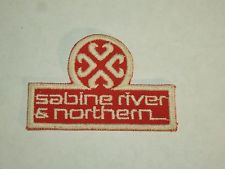 SABINE RIVER AND NORTHERN RAILROAD. The Sabine River and Northern Railroad Company was chartered on April 20, 1965. to provide rail service to the Owens-Illinois, Incorporated, linerboard mill subsequently constructed near Mulford in northeastern Orange County. The railroad was projected to run from Bessmay on the Gulf, Colorado and Santa Fe Railway to a connection with the Southern Pacific in Orange County two miles west of the Louisiana border. The capital stock was $1,000,000, and the principal place of business was four miles south of Deweyville in Orange County. Construction of the Sabine River and Northern began at Echo in late 1965, and the segment between Echo and Mulford opened on April 19, 1966. Operation of the 31½ miles began on August 17, 1967, when service was extended to Mauriceville and Bessmay.
SABINE RIVER AND NORTHERN RAILROAD. The Sabine River and Northern Railroad Company was chartered on April 20, 1965. to provide rail service to the Owens-Illinois, Incorporated, linerboard mill subsequently constructed near Mulford in northeastern Orange County. The railroad was projected to run from Bessmay on the Gulf, Colorado and Santa Fe Railway to a connection with the Southern Pacific in Orange County two miles west of the Louisiana border. The capital stock was $1,000,000, and the principal place of business was four miles south of Deweyville in Orange County. Construction of the Sabine River and Northern began at Echo in late 1965, and the segment between Echo and Mulford opened on April 19, 1966. Operation of the 31½ miles began on August 17, 1967, when service was extended to Mauriceville and Bessmay.
The mileage includes 6,800 feet of trackage rights over the Missouri Pacific Railroad at Mauriceville. Between Echo and Mauriceville the Sabine River and Northern constructed a completely new railroad. North of Mauriceville, however, the company laid its track on the abandoned grade of a Missouri Pacific branch line that once ran to Bessmay and Newton. In 1972 the railroad owned five diesel units and one car and reported a net income of $172,000. The Mulford mill and the railroad were acquired by a subsidiary of what is now Temple-Inland, Incorporated, in 1986. Other Temple-Inland facilities in southeast Texas include a Temple-Inland Forest Products Corporation sawmill at Buna and a bleached paperboard mill at Evadale.
The Buna sawmill was served by the Sabine River and Northern. In order to better integrate the three mills in the area and to provide additional outlets for the production of the Evadale facility, the railroad began work on a line to Evadale in June 1988. This eight mile branch, which leaves the main line eleven miles north of Mauriceville, opened on July 19, 1990. The Sabine River and Northern connects with all four major railroads serving southeastern Texas, the Southern Pacific Transportation at Echo, the Kansas City Southern Railway at Lemonville, the Missouri Pacific at Mauriceville, and the Atchison, Topeka and Santa Fe Railway at Bessmay and Evadale. The Sabine River and Northern transports wood chips from Buna and other Temple-Inland East Texas products bound for Mulford as well as inbound chemicals and other raw materials required for the manufacture of paper. Outbound freight includes finished lumber and paper products. From the Texas State Historical Association

The mileage includes 6,800 feet of trackage rights over the Missouri Pacific Railroad at Mauriceville. Between Echo and Mauriceville the Sabine River and Northern constructed a completely new railroad. North of Mauriceville, however, the company laid its track on the abandoned grade of a Missouri Pacific branch line that once ran to Bessmay and Newton. In 1972 the railroad owned five diesel units and one car and reported a net income of $172,000. The Mulford mill and the railroad were acquired by a subsidiary of what is now Temple-Inland, Incorporated, in 1986. Other Temple-Inland facilities in southeast Texas include a Temple-Inland Forest Products Corporation sawmill at Buna and a bleached paperboard mill at Evadale.
The Buna sawmill was served by the Sabine River and Northern. In order to better integrate the three mills in the area and to provide additional outlets for the production of the Evadale facility, the railroad began work on a line to Evadale in June 1988. This eight mile branch, which leaves the main line eleven miles north of Mauriceville, opened on July 19, 1990. The Sabine River and Northern connects with all four major railroads serving southeastern Texas, the Southern Pacific Transportation at Echo, the Kansas City Southern Railway at Lemonville, the Missouri Pacific at Mauriceville, and the Atchison, Topeka and Santa Fe Railway at Bessmay and Evadale. The Sabine River and Northern transports wood chips from Buna and other Temple-Inland East Texas products bound for Mulford as well as inbound chemicals and other raw materials required for the manufacture of paper. Outbound freight includes finished lumber and paper products. From the Texas State Historical Association
Brand/Importer Information: In 1924 Stephan Schaffan, Sr. founded the Atlas Tool Company in Newark, New Jersey. In 1933 his son, Stephan Schaffan, Jr., came to work for his father at the age of sixteen. Steve Jr. built model airplanes as a hobby and frequented a local hobby shop. Being an enterprising young man, he would often ask the owner if there was anything he could do to earn some extra spending money. Tired of listening to his requests, the hobby-store owner threw some model railroad track parts his way and said, "Here, see if you can improve on this".
In those days, railroad modelers had to assemble and build everything from scratch. Steve Jr. created a "switch kit" which sold so well, that the entire family worked on them in the basement at night, while doing business as usual in the machine shop during the day.
Subsequently, Steve Jr. engineered the stapling of rail to fiber track, along with inventing the first practical rail joiner and pre-assembled turnouts and flexible track. All of these products, and more, helped to popularize model railroading and assisted in the creation of a mass-market hobby. The budding entrepreneur quickly outgrew the limitations of a basement and small garage operation. Realizing they could actually make a living selling track and related products, Steve and his father had the first factory built in Hillside, New Jersey at 413 Florence Avenue in 1947. On September 30, 1949, the Atlas Tool Company was officially incorporated as a New Jersey company.
In 1985, Steve was honored posthumously for his inventions by the Model Railroad Industry Association and was inducted into the Model Railroad Industry Hall of Fame in Baltimore, Maryland. In addition, Steve was nominated and entered into the National Model Railroad Association Pioneers of Model Railroading in 1995.
In the early 1990s, the Atlas Tool Company changed its name to Atlas Model Railroad Company, Inc.
In those days, railroad modelers had to assemble and build everything from scratch. Steve Jr. created a "switch kit" which sold so well, that the entire family worked on them in the basement at night, while doing business as usual in the machine shop during the day.
Subsequently, Steve Jr. engineered the stapling of rail to fiber track, along with inventing the first practical rail joiner and pre-assembled turnouts and flexible track. All of these products, and more, helped to popularize model railroading and assisted in the creation of a mass-market hobby. The budding entrepreneur quickly outgrew the limitations of a basement and small garage operation. Realizing they could actually make a living selling track and related products, Steve and his father had the first factory built in Hillside, New Jersey at 413 Florence Avenue in 1947. On September 30, 1949, the Atlas Tool Company was officially incorporated as a New Jersey company.
In 1985, Steve was honored posthumously for his inventions by the Model Railroad Industry Association and was inducted into the Model Railroad Industry Hall of Fame in Baltimore, Maryland. In addition, Steve was nominated and entered into the National Model Railroad Association Pioneers of Model Railroading in 1995.
In the early 1990s, the Atlas Tool Company changed its name to Atlas Model Railroad Company, Inc.
Item created by: gdm on 2018-01-11 13:23:38
If you see errors or missing data in this entry, please feel free to log in and edit it. Anyone with a Gmail account can log in instantly.
If you see errors or missing data in this entry, please feel free to log in and edit it. Anyone with a Gmail account can log in instantly.





